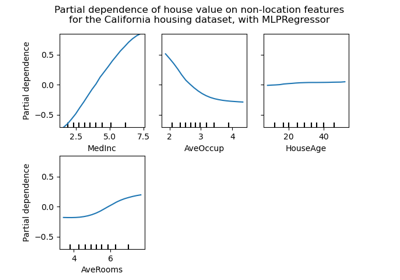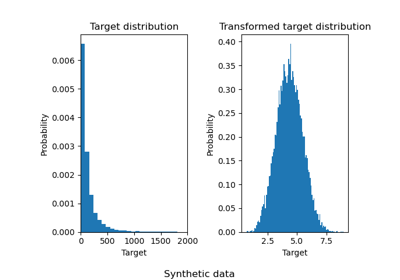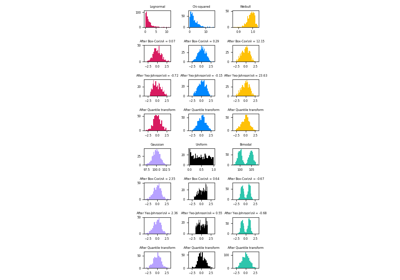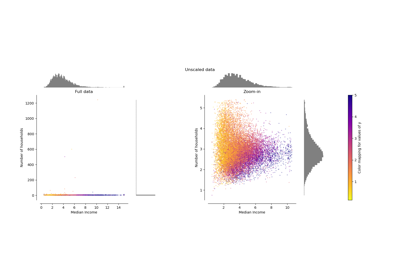sklearn.preprocessing.QuantileTransformer¶
-
class
sklearn.preprocessing.QuantileTransformer(*, n_quantiles=1000, output_distribution='uniform', ignore_implicit_zeros=False, subsample=100000, random_state=None, copy=True)[source]¶ Transform features using quantiles information.
This method transforms the features to follow a uniform or a normal distribution. Therefore, for a given feature, this transformation tends to spread out the most frequent values. It also reduces the impact of (marginal) outliers: this is therefore a robust preprocessing scheme.
The transformation is applied on each feature independently. First an estimate of the cumulative distribution function of a feature is used to map the original values to a uniform distribution. The obtained values are then mapped to the desired output distribution using the associated quantile function. Features values of new/unseen data that fall below or above the fitted range will be mapped to the bounds of the output distribution. Note that this transform is non-linear. It may distort linear correlations between variables measured at the same scale but renders variables measured at different scales more directly comparable.
Read more in the User Guide.
New in version 0.19.
- Parameters
- n_quantilesint, optional (default=1000 or n_samples)
Number of quantiles to be computed. It corresponds to the number of landmarks used to discretize the cumulative distribution function. If n_quantiles is larger than the number of samples, n_quantiles is set to the number of samples as a larger number of quantiles does not give a better approximation of the cumulative distribution function estimator.
- output_distributionstr, optional (default=’uniform’)
Marginal distribution for the transformed data. The choices are ‘uniform’ (default) or ‘normal’.
- ignore_implicit_zerosbool, optional (default=False)
Only applies to sparse matrices. If True, the sparse entries of the matrix are discarded to compute the quantile statistics. If False, these entries are treated as zeros.
- subsampleint, optional (default=1e5)
Maximum number of samples used to estimate the quantiles for computational efficiency. Note that the subsampling procedure may differ for value-identical sparse and dense matrices.
- random_stateint, RandomState instance or None, optional (default=None)
Determines random number generation for subsampling and smoothing noise. Please see
subsamplefor more details. Pass an int for reproducible results across multiple function calls. See Glossary- copyboolean, optional, (default=True)
Set to False to perform inplace transformation and avoid a copy (if the input is already a numpy array).
- Attributes
- n_quantiles_integer
The actual number of quantiles used to discretize the cumulative distribution function.
- quantiles_ndarray, shape (n_quantiles, n_features)
The values corresponding the quantiles of reference.
- references_ndarray, shape(n_quantiles, )
Quantiles of references.
See also
quantile_transformEquivalent function without the estimator API.
PowerTransformerPerform mapping to a normal distribution using a power transform.
StandardScalerPerform standardization that is faster, but less robust to outliers.
RobustScalerPerform robust standardization that removes the influence of outliers but does not put outliers and inliers on the same scale.
Notes
NaNs are treated as missing values: disregarded in fit, and maintained in transform.
For a comparison of the different scalers, transformers, and normalizers, see examples/preprocessing/plot_all_scaling.py.
Examples
>>> import numpy as np >>> from sklearn.preprocessing import QuantileTransformer >>> rng = np.random.RandomState(0) >>> X = np.sort(rng.normal(loc=0.5, scale=0.25, size=(25, 1)), axis=0) >>> qt = QuantileTransformer(n_quantiles=10, random_state=0) >>> qt.fit_transform(X) array([...])
Methods
fit(X[, y])Compute the quantiles used for transforming.
fit_transform(X[, y])Fit to data, then transform it.
get_params([deep])Get parameters for this estimator.
Back-projection to the original space.
set_params(**params)Set the parameters of this estimator.
transform(X)Feature-wise transformation of the data.
-
__init__(*, n_quantiles=1000, output_distribution='uniform', ignore_implicit_zeros=False, subsample=100000, random_state=None, copy=True)[source]¶ Initialize self. See help(type(self)) for accurate signature.
-
fit(X, y=None)[source]¶ Compute the quantiles used for transforming.
- Parameters
- Xndarray or sparse matrix, shape (n_samples, n_features)
The data used to scale along the features axis. If a sparse matrix is provided, it will be converted into a sparse
csc_matrix. Additionally, the sparse matrix needs to be nonnegative ifignore_implicit_zerosis False.
- Returns
- selfobject
-
fit_transform(X, y=None, **fit_params)[source]¶ Fit to data, then transform it.
Fits transformer to X and y with optional parameters fit_params and returns a transformed version of X.
- Parameters
- X{array-like, sparse matrix, dataframe} of shape (n_samples, n_features)
- yndarray of shape (n_samples,), default=None
Target values.
- **fit_paramsdict
Additional fit parameters.
- Returns
- X_newndarray array of shape (n_samples, n_features_new)
Transformed array.
-
get_params(deep=True)[source]¶ Get parameters for this estimator.
- Parameters
- deepbool, default=True
If True, will return the parameters for this estimator and contained subobjects that are estimators.
- Returns
- paramsmapping of string to any
Parameter names mapped to their values.
-
inverse_transform(X)[source]¶ Back-projection to the original space.
- Parameters
- Xndarray or sparse matrix, shape (n_samples, n_features)
The data used to scale along the features axis. If a sparse matrix is provided, it will be converted into a sparse
csc_matrix. Additionally, the sparse matrix needs to be nonnegative ifignore_implicit_zerosis False.
- Returns
- Xtndarray or sparse matrix, shape (n_samples, n_features)
The projected data.
-
set_params(**params)[source]¶ Set the parameters of this estimator.
The method works on simple estimators as well as on nested objects (such as pipelines). The latter have parameters of the form
<component>__<parameter>so that it’s possible to update each component of a nested object.- Parameters
- **paramsdict
Estimator parameters.
- Returns
- selfobject
Estimator instance.
-
transform(X)[source]¶ Feature-wise transformation of the data.
- Parameters
- Xndarray or sparse matrix, shape (n_samples, n_features)
The data used to scale along the features axis. If a sparse matrix is provided, it will be converted into a sparse
csc_matrix. Additionally, the sparse matrix needs to be nonnegative ifignore_implicit_zerosis False.
- Returns
- Xtndarray or sparse matrix, shape (n_samples, n_features)
The projected data.




